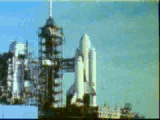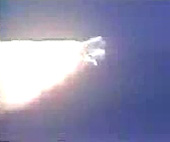The Space Shuttle
 NASA's space shuttle is the world's first reusable space vehicle.
Its formal name is the Space Transportation System (STS).
NASA's space shuttle is the world's first reusable space vehicle.
Its formal name is the Space Transportation System (STS).
The space shuttle launches into orbit like a rocket and returns to Earth like an airplane. It can then be launched again in future missions.
 The first shuttle launch was on April 12, 1981. More than 100
launches and 20 years later, the shuttle still plays a key
role in NASA's space program.
The first shuttle launch was on April 12, 1981. More than 100
launches and 20 years later, the shuttle still plays a key
role in NASA's space program.
 First-ever launch of a space shuttle: Columbia takes to the sky on April 12, 1981. NASA video.
First-ever launch of a space shuttle: Columbia takes to the sky on April 12, 1981. NASA video.
|
 The space shuttle is made up of four major parts:
The space shuttle is made up of four major parts:
- the orbiter (what most people call "the shuttle")
- the external tank
- two solid rocket boosters (SRBs)
- three space shuttle main engines (SSMEs)
 The orbiter is about the size of a DC-9 airplane. When the orbiter
is attached to the external tank and boosters and ready to launch,
the entire "stack" is 56 metres (184 feet) tall and weighs about 2
million kilograms (4.5 million pounds).
The orbiter is about the size of a DC-9 airplane. When the orbiter
is attached to the external tank and boosters and ready to launch,
the entire "stack" is 56 metres (184 feet) tall and weighs about 2
million kilograms (4.5 million pounds).
The shuttle can carry cargo into orbit between 185 and 400 kilometres (115 to 250 miles) above the Earth. All parts of the shuttle except for the external tank are reusable.
 Unlike the rockets that went before it, the shuttle is a multi-purpose
vehicle. Once its rocket boosters propel it into orbit, the shuttle
can perform many different tasks. The shuttle often uses the Canadian-made
robot arm (the "Canadarm" or remote manipulator system) to help in these tasks.
Unlike the rockets that went before it, the shuttle is a multi-purpose
vehicle. Once its rocket boosters propel it into orbit, the shuttle
can perform many different tasks. The shuttle often uses the Canadian-made
robot arm (the "Canadarm" or remote manipulator system) to help in these tasks.
Before the shuttle, satellites could be sent into orbit but could not be returned. The shuttle changed that. Today, the shuttle acts as an orbiting service centre for satellites that need repair.
 For example, the Hubble Space Telescope has been retrieved several times for
repairs and upgrades.
For example, the Hubble Space Telescope has been retrieved several times for
repairs and upgrades.
 The shuttle also collects old satellites and brings them back to Earth. Then their parts can be saved and recycled.
The shuttle also collects old satellites and brings them back to Earth. Then their parts can be saved and recycled.
The shuttle also serves as an observatory from which astronauts can study the environment of our planet. And the shuttle acts as a scientific laboratory, too.
 On each mission, the crew carries out various experiments.
Many of these experiments study the effects of living in space on people, plants,
and animals. This information will help NASA to prepare people for future long
voyages such as trips to Mars.
On each mission, the crew carries out various experiments.
Many of these experiments study the effects of living in space on people, plants,
and animals. This information will help NASA to prepare people for future long
voyages such as trips to Mars.
Between 1994 and 1998, space shuttles visited the Russian Mir space station 10 times. The Shuttle-Mir program helped pave the way for the International Space Station (ISS).
Today, the shuttle acts like a pickup truck to deliver people and supplies to and from the ISS.

|

|
Six orbiters have been built for the space shuttle program. Here is a quick summary of their names and histories:
Enterprise
- built as a test vehicle in 1977
- originally named Constitution; however, renamed after fans of the TV series Star Trek carried out a letter-writing campaign to name the first shuttle after the TV ship
- never actually launched into space

Columbia
- the oldest orbiter in the shuttle fleet
- used in the first shuttle flight on April 12, 1981
- named after an American ship that, in 1792, travelled through dangerous inland waters to explore British Columbia, Washington, and Oregon

Challenger
- the second orbiter to travel into space
- first mission on April 4, 1983
- named after a British naval research ship that sailed the Pacific and Atlantic oceans in the late 19th century
- destroyed due to a malfunctioning solid rocket booster on January 28, 1986; the accident killed Challenger's seven crew members.


|

|
 The space shuttle Challenger is destroyed by an explosion shortly after liftoff on January 28, 1986. NASA video.
The space shuttle Challenger is destroyed by an explosion shortly after liftoff on January 28, 1986. NASA video.
|
Learn more about the Challenger disaster at these web sites.
Discovery
- first mission on August 30, 1984
- named after one of the ships sailed by British explorer Captain James Cook when he explored the northwest coast of North America in the 1770s

Atlantis
- first mission on October 3, 1985
- named after the first U.S. sailing vessel used for oceanographic research

Endeavour
- first mission on May 8, 1992
- replacement vehicle for Challenger
- named after the first ship captained by James Cook, who sailed the South Pacific on it

 The shuttle's roots go back as far as the 1950s and 1960s.
During that period, the U.S. Air Force was developing a craft
called the Dynasoar, a kind of small, reusable space glider.
The shuttle's roots go back as far as the 1950s and 1960s.
During that period, the U.S. Air Force was developing a craft
called the Dynasoar, a kind of small, reusable space glider.
The name stood for dynamic soaring. But rising costs and other ways of achieving Dynasoar's goals killed the project.
In the late 1960s, NASA had its hands full with the Apollo program. But at the same time, the agency was thinking about what would come next.
In January 1972, President Nixon announced that NASA would begin a program to build a reusable space transportation system (STS). That system eventually became known as the space shuttle.
The shuttle was intended to provide low-cost, frequent access to space.
Unfortunately, it has never been cheap to operate. Today, each shuttle
flight costs U.S. $450 million or more.
Learn more about the space shuttle program.